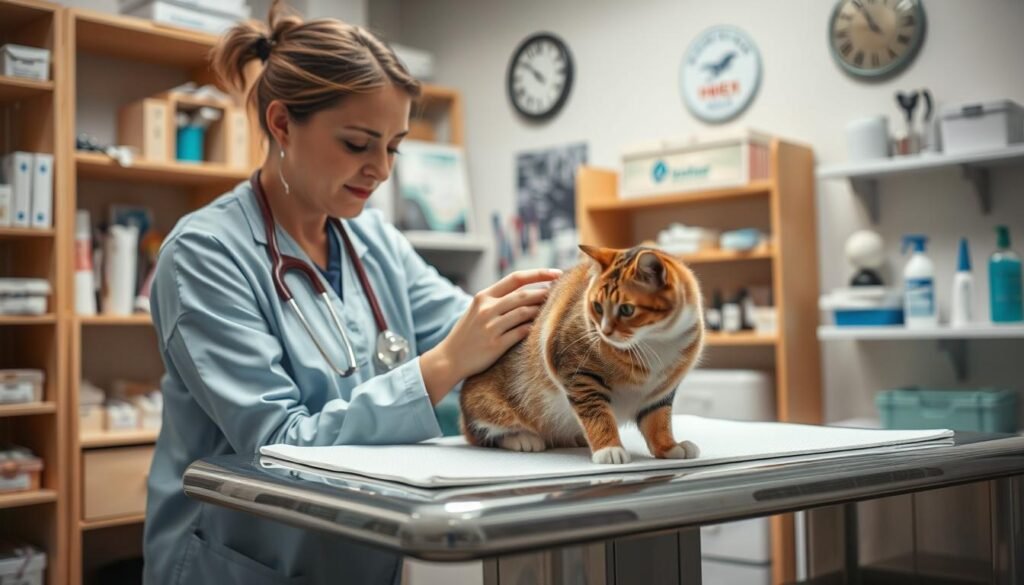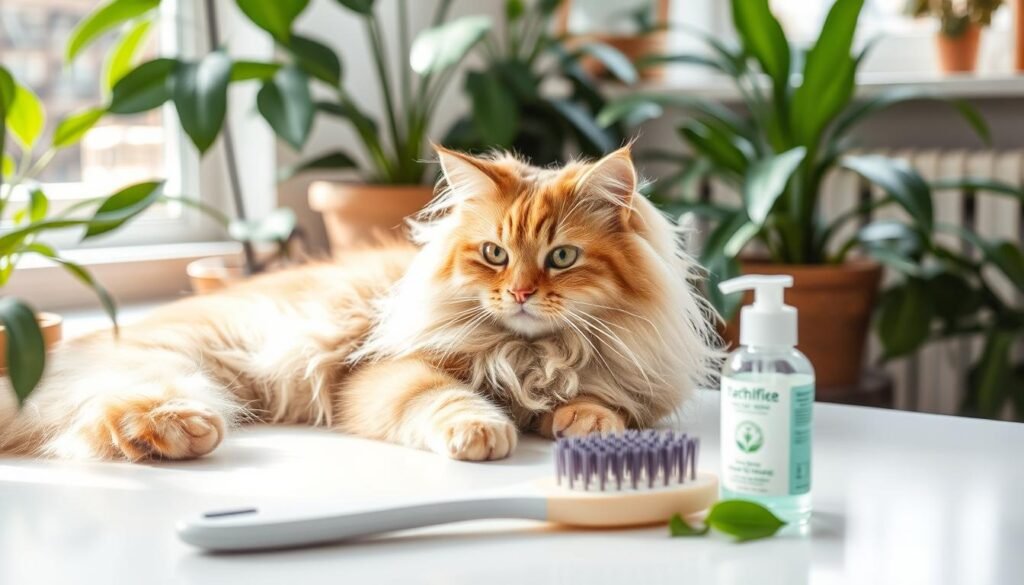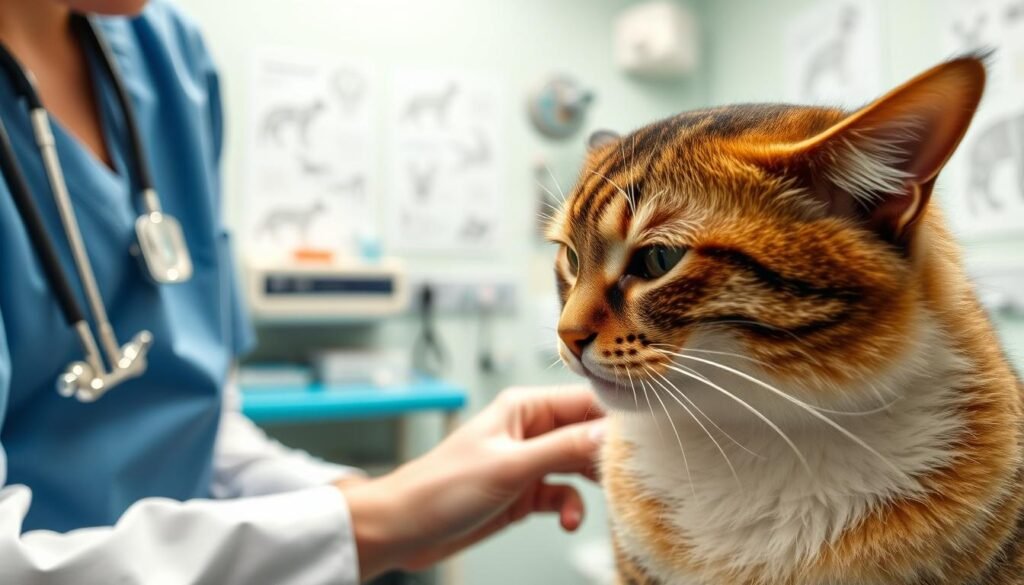Millions of hair follicles cover most pets’ bodies. These can lead to skin issues like feline folliculitis. This condition is not well understood by many but can cause serious problems if ignored. It involves the hair follicles getting inflamed. This can happen due to bacterial infections, parasites, and skin irritations. Knowing what causes it and its symptoms can help diagnose and treat it. This helps to protect our furry friends from this painful skin infection.
Key Takeaways
- Feline folliculitis is primarily linked to bacterial infections, particularly Staphylococci.
- Symptoms often include itching, redness, and significant kitty hair loss.
- Prompt diagnosis and treatment are essential to mitigate complications.
- Managing underlying conditions can greatly reduce the risk of developing folliculitis.
- Preventive measures are vital, including effective flea control and skin care.
- Veterinary consultation is crucial for accurate diagnosis and tailored treatment options.
Understanding Feline Folliculitis
Feline folliculitis is the swelling of hair follicles in cats. It happens due to different root causes. Like dogs, cats have many hair follicles that can get infected. This leads to pain and needs quick vet help to stop worse diseases.
Feline acne is a common kind of folliculitis. It mostly shows around a cat’s chin and lips. In homes with many cats, viruses or the environment might cause it. Cats with allergies to food or their surroundings can also get it, but we’re not sure how often.
When hair follicles get blocked by too much sebum, the skin turns thick, red, and crusty. This is what we see with feline acne. Dark spots may show up, suggesting blocked follicles. Mild cases might get better with creams. But, bad cases often need oral or shot antibiotics. Sadly, even with treatment, many cats get it again and again.
Keeping cats clean can help control symptoms. Regular brushing lowers the chance of these skin issues. Using bowls made of ceramic or metal instead of plastic can also help. This reduces bacteria and helps keep their skin better.
Cat owners should know the signs of feline folliculitis. It’s important to get vet care fast. Knowing about this problem can help keep cats healthy and happy.
Causes of Feline Folliculitis
It’s key to know why cats get folliculitis to treat and stop it well. Many things can make it start, affecting cats’ wellbeing. This skin problem is common but needs attention.
Bacterial Infections
Bacteria are often to blame for cat folliculitis. The Staphylococcus bacteria can get into weak hair follicles, causing redness and swelling. This usually happens when a cat’s skin is hurt or open. So, it’s important to watch for signs that your cat’s skin is not okay.
Parasitic Infestations
Parasites, like mites, also cause a lot of trouble. Demodex mites, for example, make the skin very irritated and harm the follicles. These mites like certain conditions to grow. That’s why vets always check cats’ skin closely.
Allergic Reactions
Allergies to food or the environment harm a cat’s skin. They weaken the skin, making it easy for bacteria to get in and possibly cause folliculitis. Treating allergies fast helps avoid worse skin problems.
Skin Trauma or Irritation
Things like too much grooming, accidents, or bad reactions to the environment can make the skin open to infection. Cats might scratch themselves and make it easier for bad stuff to grow. Keeping up with grooming and checking your cat often helps stop this.
Want more info on folliculitis in cats? Talk to a vet expert or click here for a thorough guide.
Common Symptoms of Folliculitis in Cats
Spotting feline folliculitis early is key to helping your cat. Common signs often point to this and other feline skin diseases. Your cat might feel a lot of discomforts, suggesting they need help.
Itching and Scratching
Cats with folliculitis can’t stop itching. They might scratch or bite their skin a lot. This makes things worse. If your cat is grooming a lot or focusing on certain spots, they’re likely very irritated.
Redness and Inflammation
You might see red areas around hair follicles. This redness and swelling show your cat’s skin is irritated. Without treatment, your cat’s health might go downhill.
Hair Loss and Hyperpigmentation
If the condition gets worse, you might see kitty hair loss. Skin might also turn darker, called hyperpigmentation. Watching for changes in coat condition is crucial for spotting serious issues.
Pustules and Papules
Sometimes, bumps full of pus appear on the skin. These bumps are a sign of an infection and mean your cat needs to see a vet right away. They show your cat might have a feline skin disease that needs checking.
Such symptoms show why regular vet visits are important. Being watchful helps catch folliculitis and other skin issues early. This ensures your cat gets the best care. For more on cat skin issues like chin acne, click here.
Diagnosis of Feline Folliculitis
Figuring out a cat’s skin infection, like feline folliculitis, needs careful work by a vet. It’s important to look closely at the cat’s health history and current state.
Veterinary Examination
The diagnosis process starts with a vet giving the cat a full check-up. Key steps include:
- Looking at the skin for signs of redness, infection, or any unusual marks.
- Taking into account the cat’s health history which is very important for making a right diagnosis.
- Finding any other health problems that might be causing the skin issues.
Diagnostic Tests
After checking the cat, the vet might suggest some tests to find out more. These tests might be:
- Skin scrapings to look for bugs living on the skin.
- Skin cytology to look at the types of cells and check for infection.
- Cultures to find any bacteria causing the infection.
- Blood tests to check for other health issues like thyroid or adrenal gland problems.
Vets know that skin problems can look different from one cat to another. They work hard to figure out the issue so they can start treating the cat quickly. This way, the cat has the best shot at getting better.

Treatment Options for Feline Folliculitis
To treat feline folliculitis well, it’s critical to know what causes it. Each treatment method tackles different aspects of this skin condition. This ensures the therapy chosen is the best one for the job.
Topical Treatments
Topical medications work great for mild skin infections in cats. These include:
- Medicated shampoos
- Creams and gels
- Ointments and sprays
- Wipes and mousses
Such items are good at fighting surface infections. Using them as instructed can really help. Symptoms get better, and recovery speeds up.
Oral Antibiotics
For bacterial infections, cats often need oral antibiotics. Treating surface infections might take three weeks to several months for tough cases. After signs go away, antibiotics should continue for 7-10 more days. This stops the infection from coming back.
Managing Underlying Conditions
Treating underlying conditions is key to fighting feline folliculitis. Issues like allergies, hormonal imbalances, and skin injuries can make things worse. Seeing a vet who specializes in skin can offer deep insights. This helps in providing complete care and improving skin health.
| Treatment Type | Description | Common Use Cases |
|---|---|---|
| Topical Treatments | Medicated solutions such as shampoos and creams. | Mild to moderate infections |
| Oral Antibiotics | Prescription medications for combating bacterial infections. | Confirmed bacterial infections |
| Management of Underlying Conditions | Addressing allergies and hormonal imbalances. | Recurring or severe infections |
Choosing the right treatments can really help cats with folliculitis. It allows for care that meets both immediate and long-term health needs.
Preventive Measures for Folliculitis
To stop cat skin troubles like folliculitis, keeping their skin healthy is key. Killing fleas is crucial since they often cause skin problems. Brushing your cat regularly helps by removing dirt and loose fur, preventing allergies or irritation.
It’s important to watch for signs of skin issues in cats. Finding and treating skin problems early can help a lot. Also, dealing with allergies fast helps avoid more serious infections. Feeding your cat a nutritious diet keeps their skin healthy. Some cats may need special care due to their genes or other health issues.
For better ways to prevent skin issues, talking to a vet skin expert helps. They can create a plan just for your cat. For more info on stopping folliculitis, check out this article on bacterial folliculitis management.

Recognizing When to See a Veterinarian
It’s key for cat owners to watch out for health issues early on. Spotting behavior changes or skin issues is crucial. Knowing when to get help from a vet is vital for your cat’s health.
Behavioral Changes
A cat that scratches a lot, over-grooms, or seems restless might be in discomfort. These signs could point to skin infections or other health issues. If you notice these changes, it’s time to get a vet’s opinion.
Visible Skin Changes
Look out for redness, swelling, crusting, or hair loss in your cat. These could be signs of an infection or allergy. Getting vet help quickly can stop worse problems and help your cat recover fast.
The Role of Feline Dermatology
Feline dermatology helps diagnose and manage cat skin conditions. It is very important for treating complex diseases like feline folliculitis. Experts in this field use advanced knowledge and tools. They aim to treat cat skin infections effectively. This leads to a smoother recovery and better life for the cats.
Importance of Specialized Care
Veterinary dermatologists deal with various skin diseases in cats. Diseases like pemphigus foliaceus and cutaneous xanthomas need special tests and treatments. Finding skin problems early is crucial.
It helps treatments work better and prevents further issues. A good plan ensures better handling of these diseases.
Collaboration with Veterinarians
General vets work together with dermatologists to treat cats. General vets might spot early signs of skin diseases. Then, they count on dermatologists for detailed checks and treatments.
This teamwork improves health outcomes. For more on feline dermatology, check this link. It talks about treatments and how they help.

This team effort helps cat owners learn how to prevent skin issues. It’s important to know what causes skin problems, like allergies and infections. Luckily, specialized care is advancing and becoming more available. Now, many cats with skin issues have hope for a better life.
Cost Considerations for Feline Folliculitis Treatment
Knowing the cost of treating a cat’s skin condition, like folliculitis, is crucial. Many factors affect the price of treatment. They show how complex it is to diagnose and treat cats’ skin issues.
First vet visits cost about $100 to $200. The vet checks the cat’s skin carefully during these visits. They might need tests for bacterial, fungal, or parasite infections, which add to the cost.
| Type of Treatment | Cost Range | Details |
|---|---|---|
| Diagnostic Tests | $100 – $500 | Includes skin scrapes, cultures, and blood work. |
| Topical Treatments | $50 – $200 | Creams or sprays may be required for specific skin infections. |
| Oral Medications | $25 – $250 | Antibiotics or antifungal agents prescribed will vary in cost. |
| Follow-up Visits | $50 – $150 | Monitoring progress and adjusting treatment, as needed. |
For serious cases, costs may exceed $500 to $1000. Owners must also budget for regular vet care. This includes follow-up visits and possible long-term meds. Lasting conditions mean a big commitment to keeping your cat healthy.
Being informed about these costs helps owners get ready financially. This way, their cats can get the right treatment for their skin conditions.
Conclusion
Feline folliculitis is common and needs attention from pet owners. Knowing the causes and spotting symptoms early helps. It allows owners to seek help quickly.
This proactive step is key to treating cat skin infections well. It leads to better outcomes. Accurate diagnosis separates it from other skin diseases, improving treatment and recovery.
With the right treatment, like topical solutions and antibiotics, and preventive care, cats can have healthier skin. Following a vet’s advice lowers the chance of it returning. It keeps cats well.
Owners should learn about feline folliculitis and see vets regularly. This care boosts the cat’s life and deepens the owner-pet bond. It leads to a happier, healthier cat.
